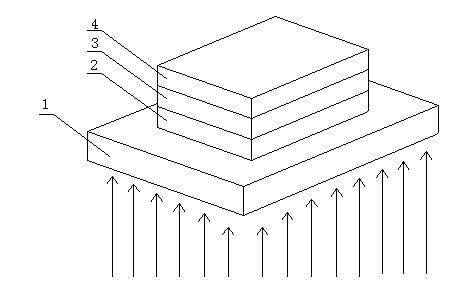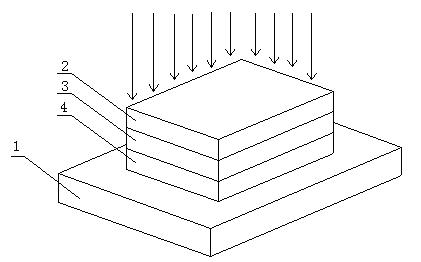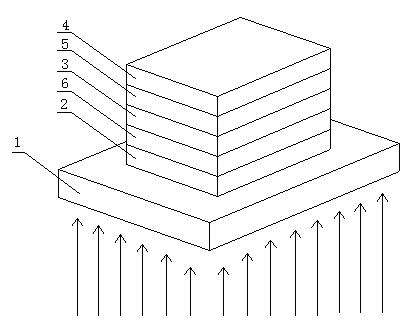Photovoltaic organic infrared semiconductor detector
A detector and semiconductor technology, applied in semiconductor devices, semiconductor/solid-state device manufacturing, photovoltaic power generation, etc., can solve the problems such as the inability to meet the detection requirements of flexible substrates, the high cost of inorganic infrared photovoltaic detectors, and the need for cooling, and achieve power consumption. Low, easy-to-array, fast-response effects
- Summary
- Abstract
- Description
- Claims
- Application Information
AI Technical Summary
Problems solved by technology
Method used
Image
Examples
Embodiment 1
[0032] Embodiment 1: A bottom-detecting photovoltaic type organic infrared semiconductor detector, using a quartz plate as the substrate 1, depositing 150nm AZO on the substrate 1 by thermal evaporation to form a high work function electrode layer 2, and dissolving it with DMSO Erbium phthalocyanine, and then spin-coat 100nm erbium phthalocyanine on the high work function electrode layer 2 with a homogenizer to form an organic infrared semiconductor layer 3, and finally deposit 150nm Mg:Ag alloy by thermal evaporation technology to form a low work function electrode layer 4.
Embodiment 2
[0033]Embodiment 2: a kind of top detection photovoltaic type organic infrared semiconductor detector, with quartz sheet as substrate 1, the Nb of 150nm is deposited on substrate 1 with magnetron sputtering method to form low work function electrode layer 4, then heat 100nm erbium phthalocyanine was deposited by evaporation technology to form organic infrared semiconductor layer 3 , and finally 150nm ITO was deposited by magnetron sputtering to form high work function electrode layer 2 .
Embodiment 3
[0034] Embodiment 3: a kind of bottom detection photovoltaic type organic infrared semiconductor detector, with quartz sheet as substrate 1, deposit the ITO of 200nm on substrate 1 with the method for magnetron sputtering, form high work function electrode layer 2, then Deposit 10nm TPD sequentially by thermal evaporation technology to form hole transport layer 6, 150nm gadolinium phthalocyanine to form organic infrared semiconductor layer 3, 10nm Alq 3 An electron transport layer 5 is formed, and finally a 150nm Mg:Ag alloy is deposited by thermal evaporation to form a low work function electrode layer 4 .
PUM
 Login to View More
Login to View More Abstract
Description
Claims
Application Information
 Login to View More
Login to View More - R&D
- Intellectual Property
- Life Sciences
- Materials
- Tech Scout
- Unparalleled Data Quality
- Higher Quality Content
- 60% Fewer Hallucinations
Browse by: Latest US Patents, China's latest patents, Technical Efficacy Thesaurus, Application Domain, Technology Topic, Popular Technical Reports.
© 2025 PatSnap. All rights reserved.Legal|Privacy policy|Modern Slavery Act Transparency Statement|Sitemap|About US| Contact US: help@patsnap.com



